
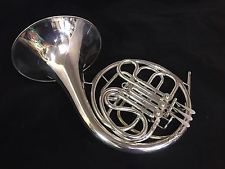

French
horns Let’s say that you’ve decided, in order to get ‘on stage’, you, or a student in your family, needs a French horn. What type do you need? Single, double, or triple? Made of nickel-silver, brass, or bronze? Silver plated, lacquered, unfinished? What maker? Rent or buy? What type of case for it – hard-shell, backpack, soft?
 OK, so there’s a lot of decisions to make, let’s try to make it simple. First of all, you were probably directed to the choice of a French horn by the junior high band director, or maybe a music store sales clerk. An experience at the school gym, where one or more stores brought out their rental stock, may have influenced you to get to this point.
OK, so there’s a lot of decisions to make, let’s try to make it simple. First of all, you were probably directed to the choice of a French horn by the junior high band director, or maybe a music store sales clerk. An experience at the school gym, where one or more stores brought out their rental stock, may have influenced you to get to this point.
Someone at these events may have suggested the French horn based on your student’s personality (success on this instrument requires a studious sort, who can work by themselves), or the shape of your student’s lips (yes, this often has an effect on their success)!
Having decided on this instrument, rather than clarinet or drums for example, there are now choices to be made. We’re back to ‘single, double, or triple’. The vast majority of beginners are directed to the single horn in F, usually in lacquered brass, a standard for at least 4 generations.
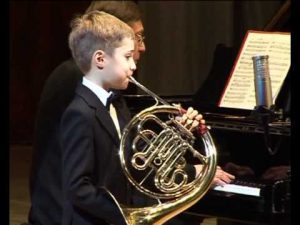 It’s a standard because 1) it gets the student used to the shape and balance of the instrument, 2) it gets the student used to all the mechanics of tone production, including work on the muscles of the lips and face, fingering combinations, and right hand position (yes, Virginia, French horn players use their right hands!), and 3) the student gets exposed to all the cool things learned in the group settings of school band and orchestra (including working together with a group of peers toward a common goal).
It’s a standard because 1) it gets the student used to the shape and balance of the instrument, 2) it gets the student used to all the mechanics of tone production, including work on the muscles of the lips and face, fingering combinations, and right hand position (yes, Virginia, French horn players use their right hands!), and 3) the student gets exposed to all the cool things learned in the group settings of school band and orchestra (including working together with a group of peers toward a common goal).
The ‘single horn in F’ (often the instrument is called ‘horn’, instead of the French horn, because every other language in the world just calls it the ‘horn’ – for further information on this, please consult the International Horn Society, www.hornsociety.org), just looking at the physical instrument, has three valves, and one set of valve tubing. It’s a common and perfectly acceptable instrument for any beginner.
A double horn will have 4 valves, and 2 sets of valve tubing. The triple horn will have somewhere between 5 and 8 valves, and 3 sets of valve tubing. The pictures above will help with identification of the type of horn. The small round objects are one end of the valve, the single horn has 3, the double 4, and this triple has 5.
 Automobile analogies might be useful here. If you walk into a large car store and say, “I want a car”, the salesperson is likely to start asking you questions in order to meet your desire, which likely will include this one , “What do you want to do with it? Race, off-road, maybe something to drive to the grocery store and back?” Choices in horns are a bit like that.
Automobile analogies might be useful here. If you walk into a large car store and say, “I want a car”, the salesperson is likely to start asking you questions in order to meet your desire, which likely will include this one , “What do you want to do with it? Race, off-road, maybe something to drive to the grocery store and back?” Choices in horns are a bit like that.
The single horn in F is the grocery store car. Here’s a link to a starting-point single F horn on Ebay.
The double horn (generally in F and B-flat), is the family sedan – it does most things well, and is adequate for almost every purpose except the very specialized.
The triple horn is the exotic race car. If you’re starting a career as a free-lance horn soloist, performing with great orchestras all over the world, the triple is for you. You will likely need a home loan as well, because a triple horn built by a reputable maker will set you back about US$18,000 or more (that is not a typo!).
Cost on your shiny new single horn in F is likely to be around US$2,000. This is for a horn built by an American, Japanese, or European company with a long history of manufacturing musical instruments.


A word about quality will be useful here, and maybe another auto analogy. At some level, a car is a car – the Yugo was a car, and the Bentley is a car. Both will get you from point A to point B (well, if the Yugo is running!) Both have 4 tires and a steering wheel. Prices on the two, reliability of the two, warranties on the two, are vastly different.
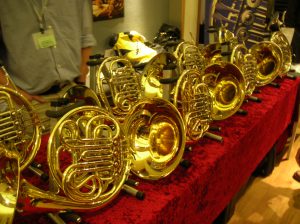 The same is true of French horns. You can buy a French horn shaped object, brand new, for around US$500. But would you trust your student to learn successfully on it? Would you attempt to teach your student to ride a bicycle that had 1 square wheel? The same is true of horns. Before investing US$2,000 (or the monthly rent – check the contract – is it a ‘rent to own’, or is it straight rent?), have a knowledgeable person (start at the top – check your local college with a music school for a French horn instructor) look the instrument over and play it, before you commit.
The same is true of French horns. You can buy a French horn shaped object, brand new, for around US$500. But would you trust your student to learn successfully on it? Would you attempt to teach your student to ride a bicycle that had 1 square wheel? The same is true of horns. Before investing US$2,000 (or the monthly rent – check the contract – is it a ‘rent to own’, or is it straight rent?), have a knowledgeable person (start at the top – check your local college with a music school for a French horn instructor) look the instrument over and play it, before you commit.
The making of musical instruments is an unusual area in modern manufacturing. Did you know that the entire musical instrument industry, world-wide, all added together (including the violin family, church organs, music publishing, guitars, band instruments, drums, cases, stage and studio electronics, ALL of it), is not big enough to make the Fortune 500?
This means that the really big factories that make French horns might have 15 employees, so inconsistencies at these factories are not unusual. As a repair technician for 35 years, I have seen well-made horns from reputable makers that play like a sock was stuffed in them, and I’ve seen really sadly-constructed horns from unknown brands that play quite well. The final word on quality is the opinion of the very-well-trained teachers which dot the landscape world-wide. Seek them out.
It might also be helpful to consult with the International Horn Society, www.hornsociety.org . Their members, who are players, teachers, and enthusiasts, are world-wide, and there are a great deal of resources at their site.
 Back to your choice on the single horn in F. If it meets all the requirements (plays well, reputable maker, price is reasonable, warranty is adequate, comes with case and mouthpiece), you can feel comfortable committing to buying/renting this instrument. And the very last word, on which your student’s success depends, is ‘practice‘. Nobody gets good on any instrument without practice. Every day. Without fail.
Back to your choice on the single horn in F. If it meets all the requirements (plays well, reputable maker, price is reasonable, warranty is adequate, comes with case and mouthpiece), you can feel comfortable committing to buying/renting this instrument. And the very last word, on which your student’s success depends, is ‘practice‘. Nobody gets good on any instrument without practice. Every day. Without fail.
See you ‘on stage’!
– your comments are welcome!
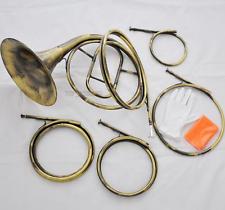
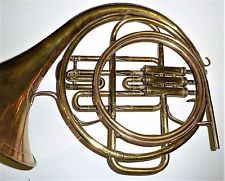

Hi, A Habil, and thanks for your comment! Alto horn is very similar to the French horn, and often plays the same parts. The best place to start research on how to play the horn would be the International Horn Society, at http://www.ihs.org. They have members from all over the world who love the horn, and a great many teachers contribute.
Best wishes for your success!
Wow, a very detailed write up about french horn. I used to watch my brother playing with his horn when he was practicing for his band. But I think it was alto horn, not the one like what you have in picture.
Hurmm, do you have any page or website for a completely beginner like me to start learning horn from scratch?
Thanks